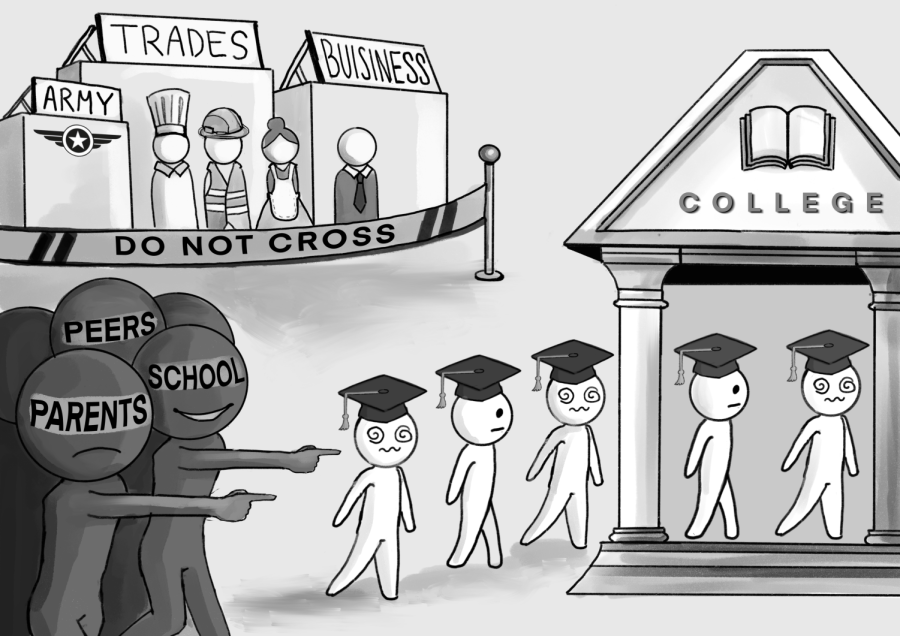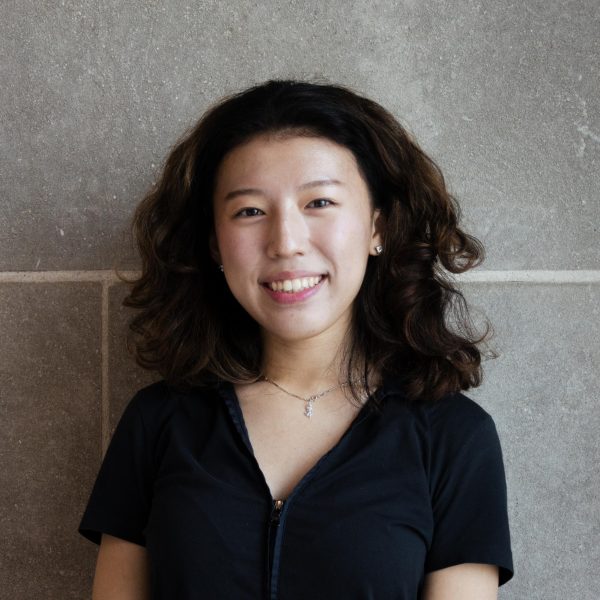Editorial: 96% of Central students go to college. It doesn’t need to be that way.
October 25, 2022
It’s October and that means it’s college season. Seniors are scrambling to put together their essays for the Nov. 1 deadline, counselors visited classes to talk about Schoolinks and Juniors recently took the PSAT. All of it is college-oriented.
Starting in sixth grade, students start hearing about applying for college and standardized tests. The issue arises when other post-secondary options such as the military, trade schools and gap years are given only slight and unenthusiastic mentions if they are brought up at all.
The lack of discussion on alternative options continues into high school. Our College & Career Center, while meant to help students with all of their postsecondary plans, focuses on helping students pursue college. Furthermore, all students, especially juniors and seniors, receive emails and in-person announcements during homeroom about the SAT and college applications, but little to none about other options.
One largely understated opportunity is the Armed Services Vocational Aptitude Battery (ASVAB) Career Exploration Assessment, held this year on Oct. 29 and Nov. 5. It’s highly recommended for those interested in the military. But aside from a meager handful of emails sent out by the school, students were left to learn about the assessment on their own.
That’s not to say our school does absolutely nothing for those interested in plans other than college. Regular military visits provide some opportunity for students, and counselors will talk about alternative options if asked but there’s not an equal amount of coverage given to each path. If a student wants to pursue an option other than college there are limited resources and help available for them within the school.
The issue doesn’t stem from the structure of Central, but rather, school culture. Students have the freedom to explore other fields in their courses and not have the picture-perfect high school transcript. However, counselors and even peers push students to take courses geared towards college. Add this to the ever-present pressure from family, and students can think that college is their only option when it isn’t.
To an extent, the lack of coverage for alternative postsecondary options is a result of, and reflects, student interest; the truth is, the majority of students want to attend college. It simply isn’t cost-effective to provide complete equity in the resources given to trade school and the military. Paying a “trade” counselor, for example, would not make sense.
On the flip side, the lack of coverage for non-college options—announcements, emails—can also be seen as a cause of the lack of student interest. If postsecondary options aren’t even on students’ radar, how can we expect them to be interested?
There is no easy, quick solution to fostering a culture accepting of other postsecondary paths. Maybe hiring additional faculty dedicated to this end isn’t the best solution. But, the little things matter: publicize trade school and the military through announcements. Communicate important dates and deadlines for those students. Invite successful alumni who didn’t attend college to share advice. Going against the grain, choosing another postsecondary direction, shouldn’t seem like a violation of school code.
While the 2021-2022 School Profile documents that 96% of the student body is attending college, this percentage could decrease as awareness is increased for other options. And that shouldn’t be seen as a bad thing.
Ultimately, our school should provide students with knowledge on all of our options so we can truly have the freedom to make our own decisions about our futures.









Adam Matolak • Oct 26, 2022 at 11:00 am
A well written article on an issue that affects not only high schoolers currently scrambling to get applications submitted, but also, and this is something not often discussed, current first or second year college students who have felt the immense pressure, whether from peers, parents, or educators, to attend college at all costs and end up going into their first year undecided in their major where a gap year to explore options would have been immensely beneficial for the individual instead. While there is nothing inherently wrong with going into your first year as an “undecided” college student, this is often a result of pressure to simply attend college without a concrete plan on what it is you are even studying in college.
Mind you, attending college is one of the more expensive financial decisions one makes during their lifetime and students only just entering adulthood are feeling the pressure of needing to attend college immediately after high school even if that means paying for classes that do not set you on a direct path for a degree. This pressure often manifests itself in either feeling lost with no path in college or dropping out all together to avoid further costs (in both time AND money) all while feeling disenchanted by the experience. Students need to feel supported even if they don’t think they have a path yet so that decisions are being made based on their own needs and wants, not based on external pressures that can often lead them to unwanted outcomes.
Graduating high school should feel like an open door to one’s favorite store where one has the ability to browse, get a feel for what is available, and only then decide on what to purchase. It should not feel like being at the end of a high dive board with only one way down, plunging towards uncertainty feeling like it was your only option.